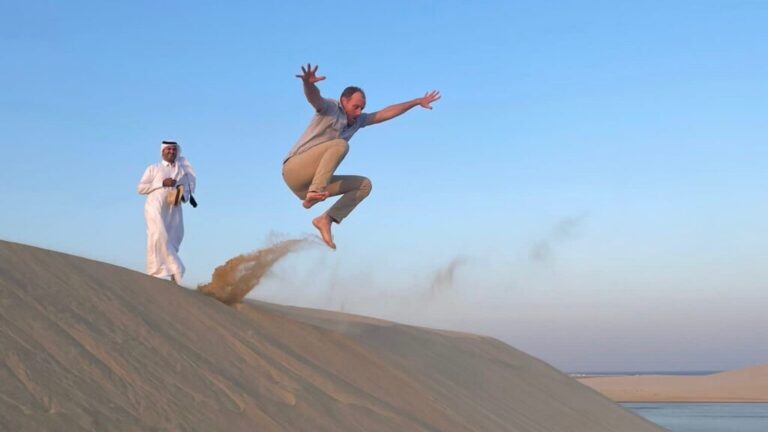Expect amazing. That was the slogan that helped win Qatar the right to host the 2022 World Cup. So when I visit the tiny Middle Eastern state, I’m expecting to be amazed.
Qatar doesn’t disappoint. It’s the mix of East and West, new and old, in a country the size of Yorkshire that leaves me both amazed and dazed. The capital city, Doha, is a hub of skyscrapers on the edge of a desert. On the sci-fi skyline, minarets peek out between spaceship-shaped hotels and high-rises.
My berth, the five-star Mondrian, is a kind of ambassador of amazement. In my room on the 17th floor, I find a welcome note from the Guest Experience Team: “We hope you enjoy your stay here at our wonderland.” In the lobby, a black spiral staircase leads up to… nowhere. Turns out it’s an artwork.
Sticking up into the Persian Gulf like a hitch-hiker’s thumb, this country-on-the-move is super-rich thanks to oil and gas. Yet its Islamic culture means polygamy is legal but homosexuality isn’t. You can’t live with your girlfriend unless married. The hope was that modernising ahead of the World Cup would force reform, but the harsh conditions of migrant workers are reported to have led to a spate of deaths.
It is hard to get a local reaction to these charges — mainly because I don’t meet many locals. Most of the 2.8 million population, and all the waiters and drivers I encounter, are expats from South Asia. Yet when I approach Abdullah, a young Qatari I find sucking on a shisha in an upscale beach bar, he is happy to discuss Western criticisms of his country. Regarding the treatment of workers, he tosses back his ghutra (Qatari headdress) dismissively. “My government respects foreign workers more than its own people,” he declares.
An electrical contractor, Abdullah says he finds it hard to hire foreigners because of the surge in regulation. Despite my interrogation, his charm never falters. He even pays for my coffee.
My second experience of Qataris comes on a ‘dune-bashing’ trip. My group explores the desert, not on camels, but in a pair of Lexus 4x4s, driven by Samir and Ismail. It’s quite a ride, as our heavy cars crest the gentle rise of each dune, then tilt over the drop before swooping down through the soft sand like snowboards.
Swimming at dusk in the Inland Sea, where ocean directly meets desert, is properly amazing. I dry off and watch the sun settle like a red tennis ball on the horizon. Beside the Lexus, Samir discreetly lays down a prayer mat and faces Mecca. Later, Ismail talks cheerfully about his two wives and how keen he is to find a third.
He also treats us to some useful if sobering desert lore. In summer, a traveller lost among these dunes will die within four hours without water. Happily, we do have water. It is also mid-November, when temperatures are like those of an English June. This, then, is the kind of climate our footballers will face here later this year.
Some have suggested that the army of fans accompanying the teams won’t find enough to do between matches. That’s nonsense. They can explore the desert, which is just an hour out of Doha. Or, if they stay in the capital, there are beaches, art galleries and world-class restaurants.
It’s easy to get around, thanks to the new Metro system — and easier still to book an Uber, which costs half what it would in the UK. For £4, I reach the public beach at Katara, in mid-city. Westerners are asked to respect Islamic modesty, so no Speedos for men; T-shirts over bikinis for women.
The beach is segregated into a family section and one for men, though when I’m there it all seems quite relaxed.
Doha prides itself on being the safest city on Earth, meaning there is no risk of getting mugged. Perhaps the greatest danger you face here is ‘amazement fatigue’. The clash of religious conservatism and rampant capitalism can be wearing.
When I’m there, the highlight of the contemporary art scene is a show by Jeff Koons. I stare at his childlike Balloon Dog (Orange), which broke auction records in 2013, as Qatari women eye it askance from behind their hijabs.
Koons’s brash consumerism sits uneasily beside the carpets and pearls of the nearby National Museum of Qatar. Yet even the latter, leading you expertly through millennia of history and heritage, is a modern marvel. The building has no straight lines and was designed to resemble a ‘desert rose’ — a flower-like crystallisation of gypsum found in the desert.
At Souq Waqif, I admire trays of colourful incense and barter for a beautiful pair of bowls. Stepping out of the ancient marketplace, I’m confronted by Le Pouce, an enormous gilded thumb by the French sculptor Cesar Baldaccini.
Even in the new airport, amid outlets of Harrods and Dolce & Gabbana, the call to prayer is intoned over the intercom. The clash of cultures is, truly, ‘amazing’.
TIPS WHEN OUT AND ABOUT
WHAT TO WEAR: Trousers, not shorts for men. Skirts below the knee. On public beaches, wear a T-shirt over a bikini.
LANGUAGE: Qataris speak Arabic, but the most common language is English.
MONEY: The currency is the riyal. £1 is worth about 5 riyal.
BOOZE: Alcohol isn’t illegal but being drunk and carrying it in public are. Some hotel bars and restaurants are licensed. The legal drinking age is 21. Alcohol is expected to be sold at stadiums during the World Cup.
WORLD CUP: From November 21 to December 18 (fifa.com).

